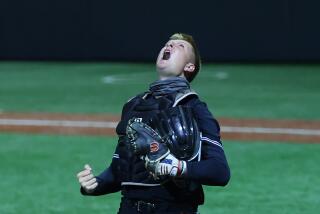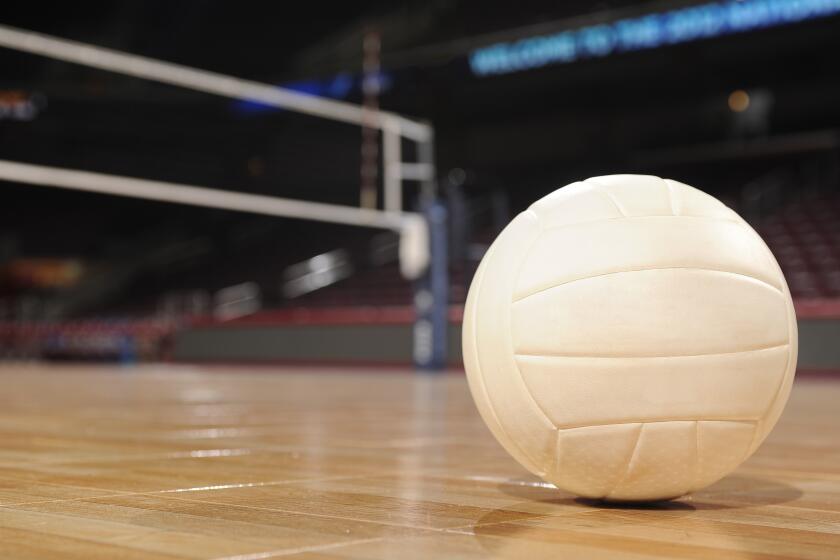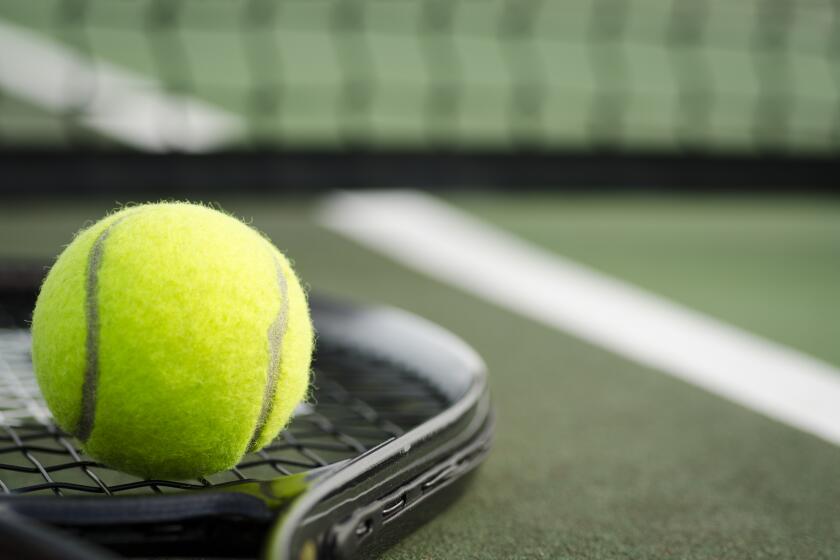Baseball Program Offers Field of Dreams to Minority Students : Santa Monica College to Train Coaches and Provide Instructors to Teach Study Skills, Give Academic Advice at Practice Fields
- Share via
Isaac Burton adjusted his grip on the ball and checked first base, staring out of the city ballpark into the setting sun.
The lanky 15-year-old pitcher nursed a slender lead and knew that a hit in this last inning could ruin everything, put two men on base and bring the Dukes’ best slugger to bat with only one out. Burton checked first again, then let loose his best--before a mighty swing rocketed a line drive to left field.
But in a blink of an eye, a racing Bisons outfielder scooped up the ball and hurled it home. Suddenly, the runner was out at the plate and, moments later, the hitter was trapped between second and third. Isaac smiled as he ran off the field, slapping his teammates’ hands. This night, the 13-, 14- and 15-year-olds were champions of the Harvard Recreation Center and had won the right to play the winners from a neighboring park.
For an instant, John T. Young, 40, founder of Reviving Baseball in Inner Cities, could see his field of dreams here in South-Central Los Angeles turn into reality.
Path to College
With the blessing of major league baseball, the city of Los Angeles and the Los Angeles Unified School District, Young and a group of boyhood friends have worked since 1987 to re-create the circumstances of their youth, when baseball was their love and, ultimately, the path that led out of the inner city to college and beyond.
“I grew up in South-Central L.A., and I played at the parks, which we are using now, as a kid, and I was a rough kid,” said Young, a major league scout who grew up near 103rd Street and San Pedro Boulevard.
“I see myself in some of these kids . . . doing dangerous stuff. . . . If it wasn’t for baseball, I’d be right there with them.”
The premise for the RBI program was grounded in stark reality for Young, a 10-year veteran of professional baseball. In 1987, as a scout for the Texas Rangers, he surveyed about 40 southern California college baseball teams and found that fewer than 5% of the players were Latino; fewer than 4% were black.
To Young, those statistics, combined with the fact that 81% of the players drafted in baseball in 1986 came from college programs and that many major league players come from Southern California, spelled a problem for minority athletes and for baseball. The inner city’s best players are not winding up on a college track.
A program to fill the void after Little League and complement under-funded high school programs would give the major leagues a larger talent pool while getting more minorities into college, he reasoned.
“We’ll still be able to sign the high school kids who are ready to play professional baseball,” Young said, “but send to college those who aren’t ready.”
Young hopes the program will mean a turnaround for inner-city minority students who face a high school dropout rate far greater than Los Angeles Unified’s district three-year average of 39%. Each year, inner-city schools lose up to 35% of their students contrasted with a district-wide rate of 16%, said Pete Martinez, coordinator of the district’s Dropout Prevention/Recovery Program.
RBI will also provide discipline and guidance, the Rangers scout said.
“There was always an adult there to help me grow up,” said Young, who played Little League at Los Angeles’ Rosecrans Recreation Center in the early 1960s. “There was always a coach. (Today in the inner city), I just don’t see enough dads, enough parents out there with the kids.”
Administrative Dean
One such father belonged to a childhood friend, Robert A. Adams, 41, who is now administrative dean of community and student development for Santa Monica College. It was Adams who volunteered the services of his college when Young came asking.
“What we want to build in is the mentor, teacher, counselor,” Adams said.
In the Reviving Baseball project, Santa Monica College will train coaches and provide instructors to teach study skills and give academic advice at practice fields next spring.
Others from Young’s and Adams’ neighborhood have come back to help. At Monday’s game between the Bisons and the Dukes, Young stood next to ex-Cleveland Indians player James Clark, former San Francisco Giants player Leon Murray and Cleveland Indians scout Doug Takagawa.
Expansion Plans
Next year, if all goes according to plan, RBI will expand from 12 to 21 teams for 13- and 14-year-olds, and create 13 new teams for 15- and 16-year-olds, Young said. Now, 180 students, most of them black and Latino, from throughout the inner city play on 15-member teams at Harvard and Algin Sutton recreation centers.
Eight other cities, including Birmingham, Ala., Buffalo and Detroit, have expressed interest in RBI, Young said, and are waiting to see whether it succeeds in Los Angeles. At the Bisons-Dukes final Monday night, amateur coach Tony Blueford watched from behind the chain-link backstop as Burton led the Bisons to an 8-3 win. Blueford’s team, the Travelers, finished last this year.
From the first practice, Blueford said, his players were shy to the point of almost complete silence. Here were young men used to the meanness of the streets, yet they could not say they wanted to enjoy something as simple as playing baseball, he said. His task was simply to teach them not to be afraid of winning.
“This program is a blessing,” Blueford, said. “When something positive happens, the kids react with meekness. If it’s something negative, they’re bold; they’re coming right at you.”
Carter Mitchell, 35, a night-shift security guard who donates his days to manage Reviving Baseball in Inner Cities at the parks, puts it more simply:
“Kids deserve a choice,” he said, watching Burton and his teammates savor their victory. “You gotta give people a choice to live how they want to.”
More to Read
Get our high school sports newsletter
Prep Rally is devoted to the SoCal high school sports experience, bringing you scores, stories and a behind-the-scenes look at what makes prep sports so popular.
You may occasionally receive promotional content from the Los Angeles Times.





